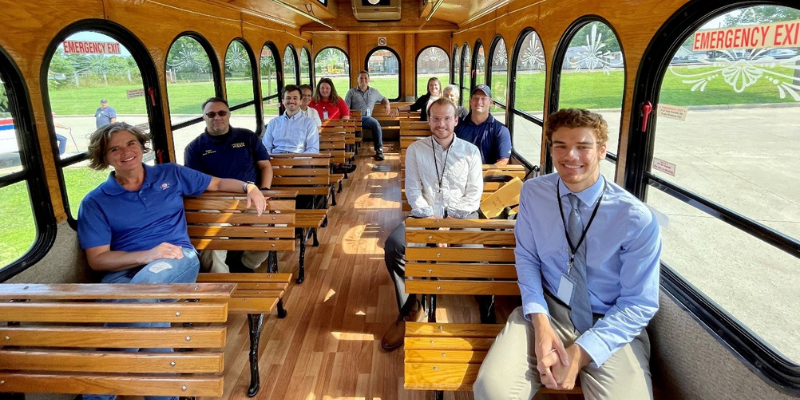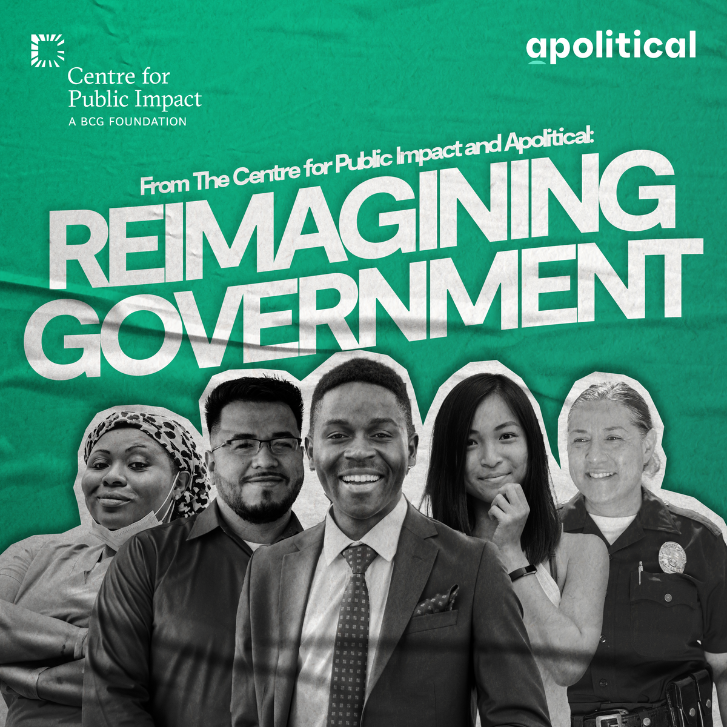

Reimagining Government episode 1: A new vision for government
Article highlights
The first episode of #ReimaginingGovernment by @CPI_Foundation and @Apoliticalco is live! 🎙️ Listen to “A new vision for government” ft. @_AdrianBrown @ProfDonnaHall @Heino1Olli @RobynScott @hourly_radio @nachiketmor @lmfeeney.
Share articleThe new podcast for public service enthusiasts is now live 🎙️ In Ep.1, @_AdrianBrown @ProfDonnaHall @Heino1Olli @RobynScott @hourly_radio @nachiketmor @lmfeeney explore bold ideas to meet 21st-century challenges.
Share articleLeadership isn’t about individuals. Leadership is a quality of a system. We need to spread that quality as widely as possible. Catch @Heino1Olli and more on Episode 1 of “Reimagining Government” by @CPI_Foundation and @Apoliticalco 🎙️
Share article🎙️ Reimagining Government
In partnership with Apolitical, this six-part podcast explores radical new approaches to addressing global issues such as the climate crisis, equitable healthcare provision, and rebuilding trust with marginalised communities. By speaking with public servants and politicians at the heart of government, we’ll shine a light on how to reimagine government so it works for everyone.
In the first episode of ‘Reimagining Government’, Adrian Brown, Executive Director at the Centre for Public Impact, examines how government can be reimagined to better respond to the modern and dynamic challenges we face today. Joining him are a host of public servants and politicians, who discuss real-world examples of better government.
Adrian Brown has over 20 years of experience working on government performance and transformation in the UK and internationally and is a former member of the UK Prime Minister’s Delivery Unit, Strategy Unit, and Prime Minister’s Office. In episode 1, Adrian explores how we can transform government by introducing people from around the world who are inspiring and implementing change.
Current systems of government, on national and international scales, risk being unable to respond to 21st-century challenges adequately. Long-standing and rigid hierarchies leave rifts between the decision-makers and the communities that the decisions affect, where communication can break down.
Real-world solutions to these issues are discussed with the leaders responsible for changing them. Today’s episode examines how we can bring the public into the decision-making process, and how government can meet society's ever-changing challenges.
“Our current models for government aren’t working. So what’s the solution?”

Adrian Brown spoke with public servants and politicians from across the world to explore these topics. We broke them down as follows:
0:00 - 01:31 - Introduction to Reimagining Government
01:32 - 8:19 - The Deal - Donna Hall on how community partnerships helped Wigan overcome the challenges of austerity
8:20 - 17:02 - Agile Government - Robyn Scott and Bruna Santos explore how Brazil trained its civil servants to rise to the challenges of the digital world
17:03 - 18:52 - Thinking systemically - Nachiket Mor discusses how different sectors can work alongside governments
18:53- 23:14 - Humble Government - Olli-Pekka Heinonen describes how government can be optimised for learning and power shared with the people on the ground
23:15 - 28:27 - Reinventing the Wheel(s on the bus) - Mayor Luke Feeney explains how workers of every level were brought in to overhaul Chillicothe’s transit system
Below are breakdowns of the episode’s key talking points.
“The Deal” - Community Partnerships
Governments looking to make change are often faced with the seemingly insurmountable barrier of budget. Adrian grew up in Wigan, and fondly remembers the strong sense of community there, but government budgets posed a real obstacle to progress in his hometown. Economic instability was mounting, and in 2010, the UK government introduced austerity measures to combat the recession.
“I think we realised back in 2011 that we had a stark choice. Do we start to cut services like other councils around us were doing or do we start to change the way we work with residents so that it’s more of a partnership than a transactional, paternalistic, parent-child relationship as very often happens with public services and the people they serve?”
Donna Hall is the Chair of New Local and former Chief Executive of Wigan Council. From 2010-2014 during her time in Wigan Council, she led what became known as ‘The Deal’.
“The Deal describes a relationship really. It’s a strategy that is essentially about we’re in this together, we’ve got to work together to get through the worst effects of austerity. We wanted to appreciate the fact that people didn't have much money and they were gonna have less money as the result of austerity so one of the things that we did as part of the deal was freeze council tax for 8 years. That meant over the 8 years an additional £500 per household per year which helped with the worst impact of austerity on families.”
The Deal was the result of examining the status quo, admitting that it was not working, and restructuring. Namely, The Deal brought the civil servants at the council together with the people of Wigan and the everyday realities of the community.
By challenging unnecessary hierarchies and collaborating across previously more rigid boundaries, Wigan has reduced expenses, improved trust, frozen council tax, and improved health outcomes.
Working with local individuals and businesses brought new perspectives to Wigan that in turn provided new opportunities for the community. In one particularly inspiring example, the manager of a local McDonald’s, who had grown up in care, helped to create new activities and youth groups to support local young people.
Shifting to more community-driven change, rather than oversight from a government that assumes they know what is best, emphasised the importance of infrastructure over the individuals running it. This in turn, created more consistency. Developing a place-based strategy co-designed with local citizens prevented policies from swapping over with a change in council leadership.
Agile Government
Historically, government structures have been pretty set in their ways, and it is easy to see why. Built on centuries of history and deeply ingrained in almost every facet of society, reshaping them can seem an impossible task.
Robyn Scott is the CEO and co-founder of Apolitical. They have compiled the ‘Agile 50’ - a list of the 50 most influential people revolutionising governments. Amongst them is Bruna Santos, Senior Advisor to the Brazil Institute at the Woodrow Wilson Centre, and former Innovation Director at the Brazilian National School of Public Administration. Bruna introduced the ‘Agile Government’ concept here, changing how over 11 million public servants are trained across Brazil's local, state, and national levels.
The two discuss the role of Agile Government and define it by four primary characteristics. These are:
A less rigid model of government that allows for quick action
Anticipating the future while constantly iterating on your existing decisions and models
Humble and collaborative leadership, removed from ego
Focusing on the needs of citizens
These characteristics provide the foundations for a government of the future. Bruna highlights that it is also crucial for public servants to be able to solve problems innovatively, work across networks, and be digitally fluent.
The importance of these qualities was demonstrated when the Brazilian National School of Public Administration delivered a number of transformation projects. For one project, government officials were taught to familiarise themselves with design research to understand how citizens interact with the country’s systems through online portals.
This informed a total redesign of the Brazilian government’s website. Part of this redesign was a move towards interoperability, whereby the country’s digital systems work more cohesively, connecting data across systems and, ultimately, delivering better services for citizens.
Thinking systemically
Models of government can often be all-encompassing, reluctant to relinquish responsibility to other sectors or actors within their system.
Nachiket Mor is Commissioner of the Lancet Commission on reimagining India’s health system and visiting scientist at the Banyan Academy of Leadership in Mental Health. His work is focused on the design of national and regional health systems in India. He believes that a shift from government - which sees its role as a facilitator rather than an administrator - could be the road to improving public services.
Mor argues that thinking systemically about how government can work alongside the private and non-profit sectors could unleash a future that brings in more professionals' expertise and enables government to unlock local solutions.
Humble Government
Olli-Pekka Heinonen is Director General of the International Baccalaureate Organisation, a global leader in international education, and was previously Finland’s Minister of Education and Science, and Director General of the Finnish National Agency for Education.
Like Mor, Heinonen and others working in the Finnish government recognised the need for governments to do things differently, resulting in an approach that the Finnish government describes as ‘Humble Government’.
“The constant change in contexts of citizens, higher expectations, and limited resources meant that we had to create something new. Because of that, there was an approach to create a better functioning culture for public service and for the government, and that was named Humble Government.”
Humble Government has helped improve government effectiveness and enabled the Finnish government to deal with 21st-century challenges.
This model moved control from the national government to the hands of people working on the ground. In terms of education, schools, teachers, and students were consulted on the changes and support they needed to overcome the challenges facing them.
This example of government innovation promotes leadership as a quality of the system, as opposed to the people working as part of that system. With this comes leadership spread across a wider network, promoting shared responsibility by those best informed and equipped to make decisions.

Reinventing the Wheel(s on the bus)
Breaking down traditional hierarchies also provides a possible vision of the future of government. By changing government in such a way that challenges these hierarchies and encourages greater collaboration between teams of civil servants, new perspectives can be brought in when designing the public services that shape communities.
Luke Feeney, Mayor of Chillicothe, Ohio, realised that the government’s failure to identify the citizens' problems was restricting its ability to solve them.
“A lot of that just had to do with how we engaged with people not being so intentional about what the engagement was about - thinking through what we were hoping to gain from the engagement, and what the public could gain.”
“So making that engagement a more interactive process [gave an] outside perspective that enables us to do our jobs better and deliver services in a way that the public can appreciate a little bit more.”
When it came time to redesigning Chillicothe’s transit system, the team was made up of individuals from every level of every department. This holistic perspective on the project led to the implementation of crucial design decisions that could have otherwise been easily missed.
The result was increased efficiency across the traditional fixed routes, the implementation of a new on-demand transportation system similar to popular rideshare services like Uber and Lyft, and Chillicothe’s new downtown trackless trolley, which has become a popular attraction in its own right.
“I don’t know that I’ve ever been a part of something in the time that I’ve been in government that tackled a project [where] the results were so tangible, not to mention in such a relatively short period of time.”
 Chillicothe residents riding the trolley.
Chillicothe residents riding the trolley.
Government change can come in many forms. Across the UK and USA, Donna Hall and Mayor Feeney have demonstrated that a government that engages with the community can improve public services by directly responding to specific needs. Across Brazil, India and Finland, Bruna Santos, Nachiket Mor, and Olli-Pekka Heinonen have shown how redefining the state's role can improve government and produce better results for citizens worldwide. All of them are shaping a new future for better government, something we desperately need if we’re to address the challenges we’re facing across the globe.

🎙️ Reimagining Government
This six-part podcast explores radical new approaches to addressing global issues such as the climate crisis, equitable healthcare provision, and rebuilding trust with marginalised communities.
By speaking with public servants and politicians at the heart of government, we’ll shine a light on how to reimagine government so it works for everyone.
You may also be interested in...


5 Lessons from Olli-Pekka Heinonen and the Finnish National Agency for Education
